Hydrogen Energy Storage Market Size and Forecast 2025 to 2034
The global hydrogen energy storage market size was calculated at USD 17.59 billion in 2024 and is predicted to increase from USD 18.78 billion in 2025 to approximately USD 34.56 billion by 2034, expanding at a CAGR of 7.01% from 2025 to 2034.
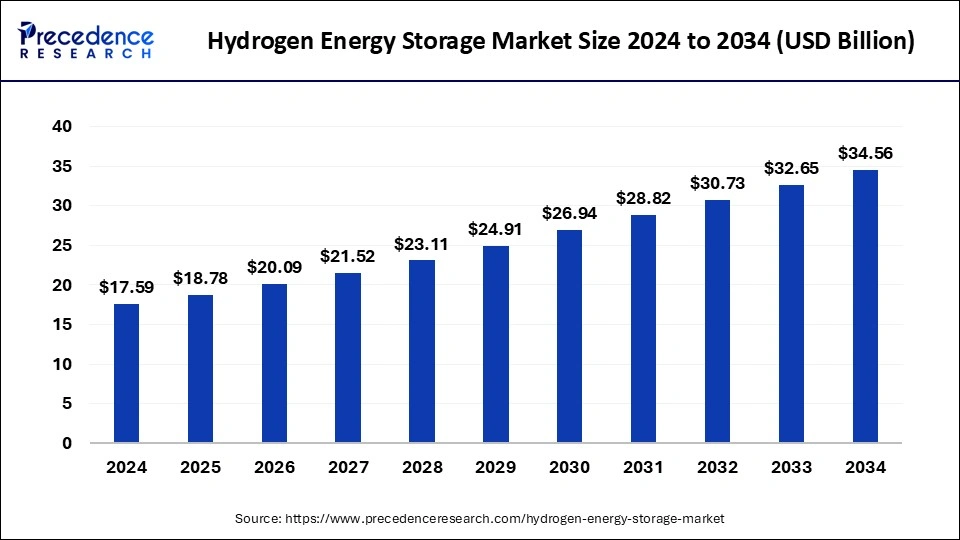
Hydrogen Energy Storage Market Key Takeaways
- The global hydrogen energy storage market was valued at USD 17.59 billion in 2024.
- It is projected to reach USD 34.56 billion by 2034.
- The market is expected to grow at a CAGR of 7.01% from 2025 to 2034.
- By application, the transportation segment held a significant share in 2024.
- By application, the transportation segment held a significant share in 2024.
- Asia Pacific led the global market with the highest market share of 36.02% in 2024.
- By Technology, the compression storage technology segment has held the largest market share of 41.61% in 2024.
- By End User, the industrial segment captured the biggest revenue share of 47.96% in 2024.
- By Physical State, the solid segment is estimated to hold the highest market share of 41.76% in 2024.
AI integration in the Hydrogen Energy Storage Market
The use of artificial intelligence is changing the hydrogen energy storage industry in terms of efficiency, reliability, and scalability of the entire value chain. AI algorithms aid in predicting renewable energy in production to create more efficient schedules of electrolysis in green hydrogen production. Parameters in storage, like pressure, temperature, and degradation of materials, are monitored and controlled in real-time by AI systems and hence offer the best performance and safety. AI will also help with the predictive maintenance of storage infrastructure and ensure less energy loss through dynamic conditioning of storage. Using AI to automate decision-making processes, AI is opening the way to develop robust and economically sound hydrogen economies.
Asia Pacific Hydrogen Energy Storage Market Size and Growth 2025 to 2034
The Asia Pacific hydrogen energy storage market size was exhibited at USD 6.34 billion in 2024 and is projected to be worth around USD 12.28 billion by 2034, growing at a CAGR of 6.86% from 2025 to 2034.
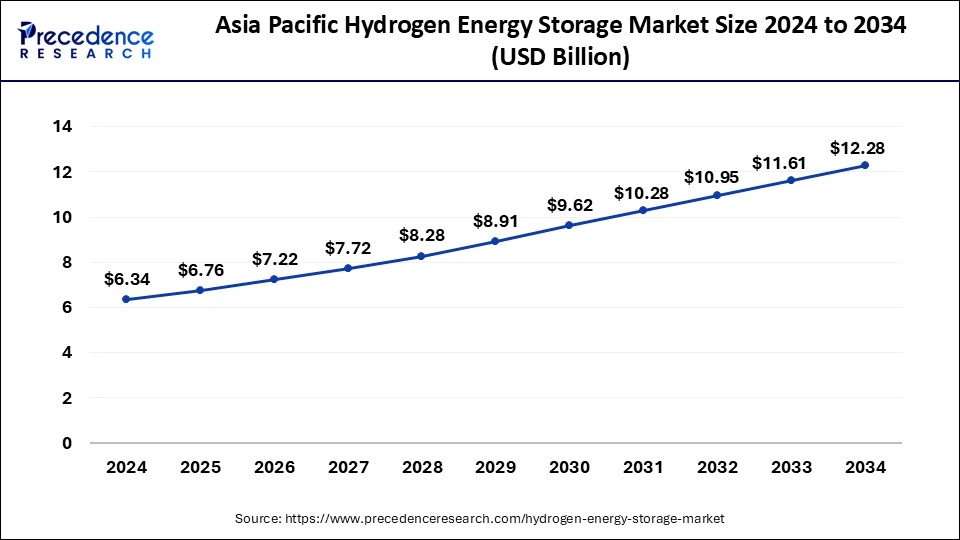
Asia-Pacific led the market with a revenue share of 36.02% in 2024. The Asia-Pacific region consists of various areas which are focusing on the development of proper resources of energy due to shortage of electricity. Thus, the hydrogen energy storage has been considered as best solution for such issues. This is contributing towards the growth of the market in Asia-Pacific region.
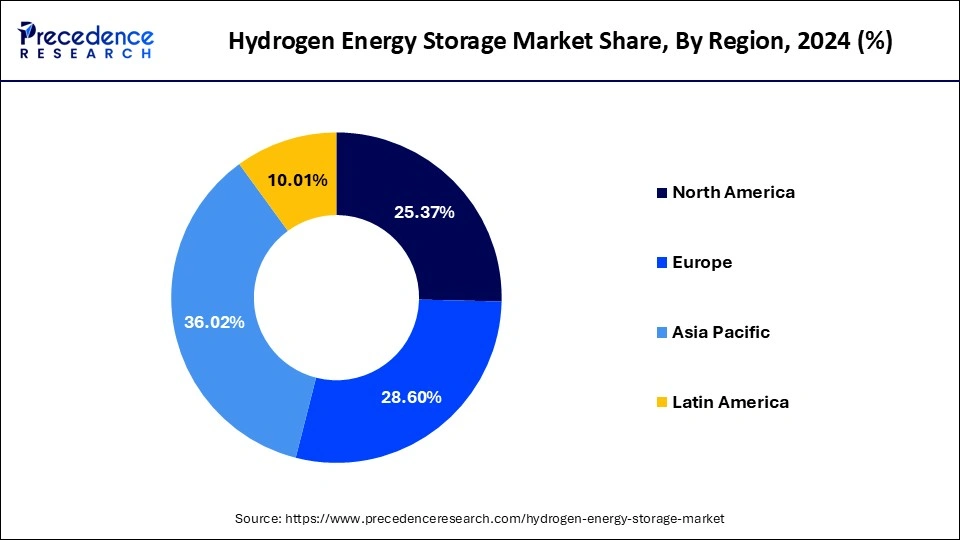
- China size accounted for USD 1,729.66 million in 2024 and is registering at a CAGR of 6.86% from 2025 to 2034.
- Japan was valued at USD 1,564.90 million in 2024 and is growing at a CAGR of 7.3% from 2025 to 2034.
- India reached USD 1,322.67 million in 2024 and is growing at a CAGR of 6.5% from 2025 to 2034
North America is expected to develop at the fast
est rate during the forecast period. The factors such as growing demand for hydrogen in various industries, stringent government regulations, and the growing demand for green energy are driving the growth of the hydrogen energy storage market in North America region. In addition, the government of developed countries such as the U.S., and Canada are highly investing in the development projects, which is driving the market growth.
U.S. Hydrogen Energy Storage Market Trend
The U.S. has been on the trajectory as the leader in innovation related to hydrogen energy storage. The growth of technologies and investment in the private sector in terms of production, storage, and transportation. Tax incentives, clean energy mandates, and good public-private linkages are also going up in the U.S. market. Hydrogen energy storage is becoming a key element in the development of a cleaner energy economy as the process of decarbonization accelerates in sectors including transport, industry, and power. The availability of policy support, infrastructure investments, and technology development makes the U.S. the leader in finding scalable hydrogen storage solutions to provide long-term energy reliability in the world.
China Hydrogen Energy Storage Market Trend
China is quickly building its market in hydrogen energy storage with high investment levels and ambitious country plans, and integration and coverage with other forms of energy, such as renewable energy. The Ningxia Baofeng Energy project, under which green hydrogen is generated through solar power and stored and operated to run industry processes, is a project that has clearly shown Chinese interest in downsizing emissions in heavy industries. With the help of a national plan for hydrogen and friendly policies, China is also working on hydrogen infrastructure, such as storage tanks, pipelines, and refueling facilities. Such coordinated actions are making hydrogen a mainstream energy carrier in China, and allow clean energy storage, enhance the flexibility of the grid, and assist with decarbonizing the economy.
Europe Hydrogen Energy Storage Market Trend
The European hydrogen energy storage market is expected to account for a substantial market share in 2024. Hydrogen energy storage is increasingly being adopted in the region due mainly to the rising number of hydrogen fuel cells in electric vehicles (EVs) and the expanding interest in low-carbon energy agendas. Hydrogen is becoming a strategic energy carrier as a component in the transformation of the region to abandon the traditional reliance on fossil fuel. This transition is enabled by hydrogen energy storage, which allows the long-term storage and delivery of hydrogen fuel, which is essential in fuel cell EVs that need rapid recharging and much longer driving range.
Governments in the region are also adopting the use of hydrogen in their long-term energy planning since they intend to diversify their sources of energy and avoid carbon emissions. Since the transport industry is moving towards zero-emission technologies, hydrogen energy storage is likely to become the key component in the energy transition and climate targets.
Market Overview
The hydrogen could be stored as a compressed gas, as liquid hydrogen, or in a solid state material such as metal hydrides. Upon the need for energy, the stored hydrogen can be converted back into electricity through fuel cells or combustion. It can be used in many sectors as it is versatile in its uses, which include power generation, transportation, and industrial activities. With the world economy moving towards a low-carbon economy, hydrogen is gaining popularity as a method of decarbonization of such hard-to-eliminate industrial processes as steel production, chemicals, and heavy transport.
The hydrogen energy storage market witnesses growth owing to the rising uptake of hydrogen as a clean and efficient alternative to fuel. The use of policies, subsidies, and regulatory systems by governments across the world to stop developing items of emission that include carbon is contributing to the rapid growth of hydrogen storage technologies. The hydrogen is being taken up by industrial sectors to fulfill decarbonization goals, and it is highly needed in highly reliable and scalable storage solutions.
Hydrogen Energy Storage Market Growth Factors
The hydrogen energy storage is widely utilized in the storage of electricity. This form of storage can help during the shortage of electric power. The hydrogen energy is widely used in the transportation industries. All the vehicles can get fuel with the help of hydrogen energy storage. The hydrogen energy storage will help during the situation of energy depletion.
The rapidly growing demand for hydrogen in the industrial applications such as metal refining, oil refineries, and fuel cell among others is one of the prominent factors for the robust growth of hydrogen energy storage across the globe. Moreover, the increasing government initiatives towards the establishment of energy-saving hydrogen stations in various countries is driving the market growth of hydrogen energy storage at a lucrative rate. Additionally, the continuous research and development activities to explore a greater number of hydrogen energy storage industrial and commercial application is further boosting the market.
Due to global warming, the government of all regions and countries are focusing towards the installation of grid power stations. The hydrogen energy is widely used in stationary power. This is due to the growing demand for clean and green energy. The emission of hydrogen energy does not involve emission of any kind of toxic gases or greenhouse gases. Thus, this is supporting the expansion of the global hydrogen energy storage market over the projected period.
In addition, the rising favorable government initiatives for the development of the hydrogen energy storage market are creating lucrative opportunities for the growth of the global market. The key market players and government agencies are highly investing in research and development activities for the development of the market. These activities also focus on the efficient and effective power supply in underdeveloped regions or regions with less or no electricity.
Market Scope
| Report Coverage | Details |
| Market Size in 2025 | USD 18.78 Billion |
| Market Size by 2034 | USD 34.56 Billion |
| Growth Rate from 2025 to 2034 | CAGR of 7.01% |
| Base Year | 2024 |
| Forecast Period | 2025 to 2034 |
| Segments Covered | Technology, Physical State, End User, Application, Geography |
| Regions Covered | North America, Europe, Asia-Pacific, Latin America, and Middle East & Africa |
Market Dynamics
Driver
Increasing Need for Renewable Energy Integration
The hydrogen energy storage market is being driven by the transition towards the use of renewable energy like solar and wind energy, which is gaining pace. This function aids grid stability and resilience, and hydrogen thus becomes a key enabler in the transition to decentralized, clean power-only systems. Hydrogen-based renewable energy storage is being extensively invested in by governments and the private industries in technologies that facilitate the use of renewable energy, since it can be a versatile and long-duration solution for energy storage. Hydrogen infrastructure is being driven further by the global trend of increased renewable energy policy, climate commitments, and clean energy-intensive goals.
- In December 2024, Houpu Clean Energy Group Co., Ltd. revealed its unique clean energy sources, emphasising the advanced hydrogen storage technology at the Oil & Gas Vietnam Expo 2024 held at AURORA EVENT CENTER in Vung Tau, Vietnam.
( Source: https://fuelcellsworks.com )
Restraint
High Initial Investment Costs
The significant limitation that the hydrogen energy storage market is likely to face is the high cost of initial capital that should be invested in the development of infrastructure. Creating a hydrogen storage ecosystem is an extremely expensive undertaking to have the equipment in place to generate hydrogen via the use of electrolyzers, high-pressure storage tanks, liquefaction systems, and also satisfying transportation and distribution networks. Also, the green hydrogen production, which is based on electrolysis powered by renewable sources, is much more costly than the conventional. Increasing costs of development are necessitated by the requirements of highly complex engineering designs, safety mechanisms, and the use of advanced materials.
Opportunity
Government Policies and Incentives
The government support is emerging as a major prospect for kick-starting the market for hydrogen energy storage. Nations worldwide are announcing in-depth policies, subsidies, and funding programs to activate research, development, and implementation of hydrogen technologies. There are federal grants and tax credits that help to finance infrastructure proposals and pilot programs related to hydrogen storage and transportation. The government intervention is also helping the industry by ensuring that there is a positive regulatory and financial environment, thus giving the industry a boost and making it a pillar in the new clean energy world.
As the importance of energy consumption is rising, the demand for the hydrogen energy storage is also rising. One of the key factors driving the growth of the global hydrogen energy storage market is the rising usage offuel cell vehicles. The market for hydrogen energy storage is also rising due to the surge in demand for energy storage. Furthermore, the hydrogen energy storage is considered as cost-effective storage solution for the key market players. The innovation and technological advancements are paving way for the expansion and development of the market over the forecast period.
On the other hand, the stringent government regulations regarding production of hydrogen through the process of electrolysis is hampering the growth of the global hydrogen energy storage market. In some of the regions, the production and application of hydrogen is not allowed. The production process can harm the lives of people who are working in the factories.
Moreover, the production of hydrogen requires good number of raw materials. The lack of good supply chain management can lead to the disruption in the hydrogen production process. The production cost of hydrogen is considered as high in nature, which is restricting the growth of the market.
The surge in demand for hydrogen energy storage in the developed and developing regions such as Europe and North America is propelling the growth of the global hydrogen energy storage market. The government of those regions is constantly taking measures and initiatives for the conservation of the energy. Additionally, the government is also collaborating with the major market players for the development and growth of the global market. The government agencies are also providing incentives and subsidies for the installation and maintenance of hydrogen energy storage plants in underdeveloped regions. All of these aforementioned factors are boosting the market growth.
Application Insights
The transportation segment led the hydrogen energy storage market and accounted for the largest revenue share in 2024. The increasing popularity of zero-emission vehicles and the shortcomings of the conventional battery-electric cars in heavy-duty and long-haul transportation domains. Hydrogen fuel cell vehicles (FCVs) come in many forms: passenger cars, buses, trucks, and trains, but all run using the storage of hydrogen in high-pressure tanks that create electricity in fuel cells. Hydrogen mobility is also supported by governments around the world in terms of tax incentives, development of fuel infrastructure, and tightening of emissions standards.
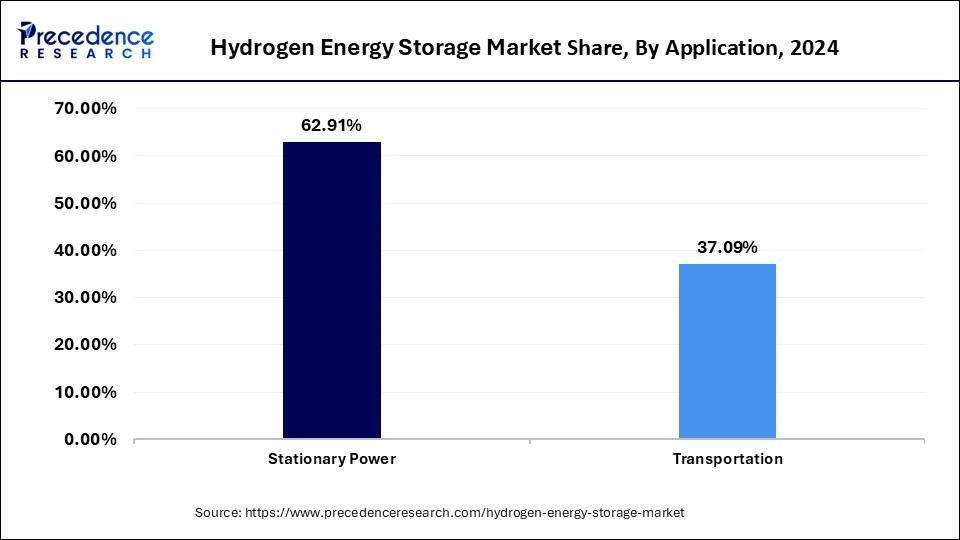
Hydrogen Energy Storage Market Revenue, By Application, 2022 to 2024 (USD Million)
| By Application | 2022 | 2023 | 2024 |
| Stationary Power | 9,760.59 | 10,389.15 | 11,066.82 |
| Transportation | 5,835.78 | 6,169.07 | 6,525.92 |
The stationary power segment is expected to grow at a significant CAGR over the forecast period. Driven by growing interests in grid resilience, grid backup power, and renewable energy inputs. The storage of hydrogen energy in this sector allows for the storage of excess renewable energy (solar and wind) by undergoing electrolysis. Hydrogen storage provides a very long-duration solution without emissions as compared to conventional diesel generation and banks of lithium-ion batteries. It also helps in stabilizing the grid and frequency, as well as enhancing load balancing. The uptake of hydrogen energy storage in stationary use is due to government incentives and continued technological improvement in hydrogen design to increase its electrolysis efficiency, storage density, and cost.
Technology Insights
The compression storage technology segment accounted market share of around 41.61% in 2024. The compression storage technology is most widely used technology for the hydrogen energy storage. This technology helps to store huge amount of energy in cylinders. Later this energy is used in various industries.
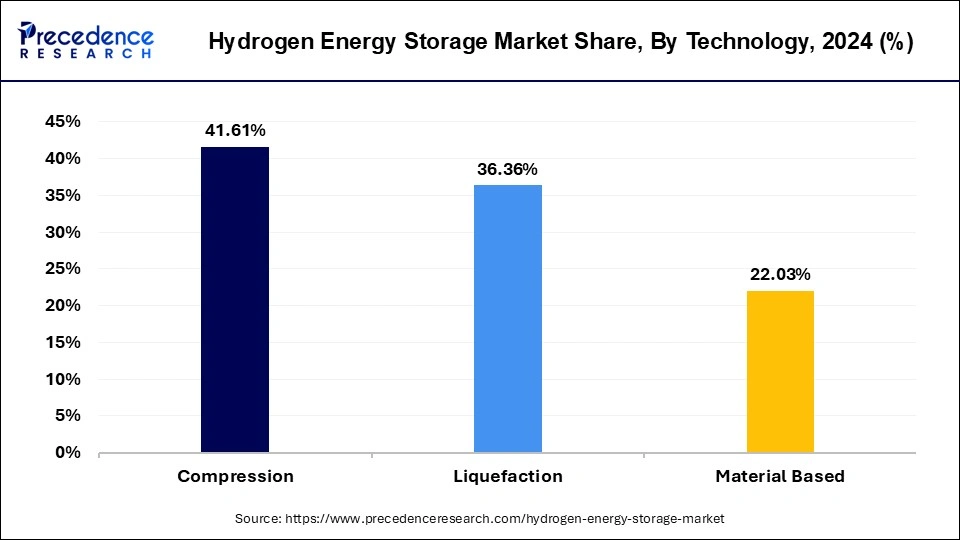
The liquefaction technology segment is fastest growing segment of the market in 2024. Mainly the liquefaction technology is used for the storage of large amount of energy for industrial purposes. With the help of this technology, the transmission and transport of energy is quite easy. Thus, this factor is driving the growth of the segment.
- The compression segment has accounted USD 7,319.76 million in 2024 and registering at a CAGR of 6.64% from 2025 to 2034.
- The material based segment has reached at USD 3,875.83 million in 2024 and is growing at a CAGR of 7.89% from 2025 to 2034.
Hydrogen Energy Storage Market Revenue, By Technology, 2022 to 2024 (USD Million)
| Technology | 2022 | 2023 | 2024 |
| Compression | 6,533.88 | 6,913.08 | 7,319.76 |
| Liquefaction | 5,685.69 | 6,028.65 | 6,397.15 |
| Material Based | 3,376.80 | 3,616.50 | 3,875.83 |
End User Insights
The industrial segment garnered a revenue market of 47.96% in 2024. The hydrogen is used in industries for various processes. Some of the manufacturing processes require hydrogen energy. The stored hydrogen is used in the electricity generation process as well.
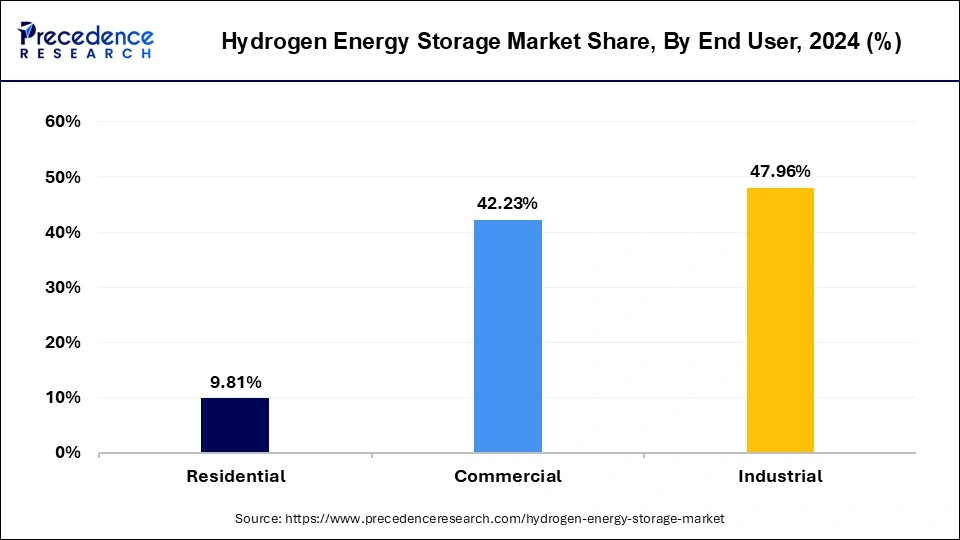
The commercial segment is fastest growing segment of the market in 2024. Due to shortage of energy and electricity in some areas and growing number of infrastructural development projects, the demand for hydrogen energy storage is increasing at a rapid pace at commercial areas.
- The industrial segment accounted for USD 8,436.81 million in 2024 and is growing at a CAGR of 6.58% from 2025 to 2034.
- The commercial segment was valued at USD 7,430.24 million in 2024 and is growing at a CAGR of 7.64% from 2025 to 2034.
Hydrogen Energy Storage Market Revenue, By End User, 2022 to 2024 (USD Million)
| End User | 2022 | 2023 | 2024 |
| Residential | 1,550.71 | 1,635.28 | 1,725.69 |
| Commercial | 6,507.44 | 6,951.04 | 7,430.24 |
| Industrial | 7,538.22 | 7,971.90 | 8,436.81 |
Physical State Insights
In 2024, the solid segment led the market with a 41.76% revenue share. The hydrogen is stored in solid form for a specific period of time. Later, this stored hydrogen energy is converted into liquid form.
The liquid segment, on the other hand, is predicted to develop at the quickest rate in the future years. The liquid form of hydrogen energy is used in a wide range of applications such as industrial and commercial purposes.
- In terms of revenue, the solid segment accounted for USD 7,436.23 million in 2024 and is registering a CAGR of 6.51% from 2025 to 2034.
- The liquid segment was valued at USD 5,837.59 million in 2024 and is growing at a CAGR of 7.64% from 2025 to 2034.
Hydrogen Energy Storage Market Revenue, By Physical State, 2022 to 2024 (USD Million)
| Physical State | 2022 | 2023 | 2024 |
| Solid | 6,571.57 | 6,945.54 | 7,346.23 |
| Liquid | 5,113.97 | 5,461.84 | 5,837.59 |
| Gas | 3,910.83 | 4,150.84 | 4,408.92 |
Hydrogen Energy Storage Market Companies
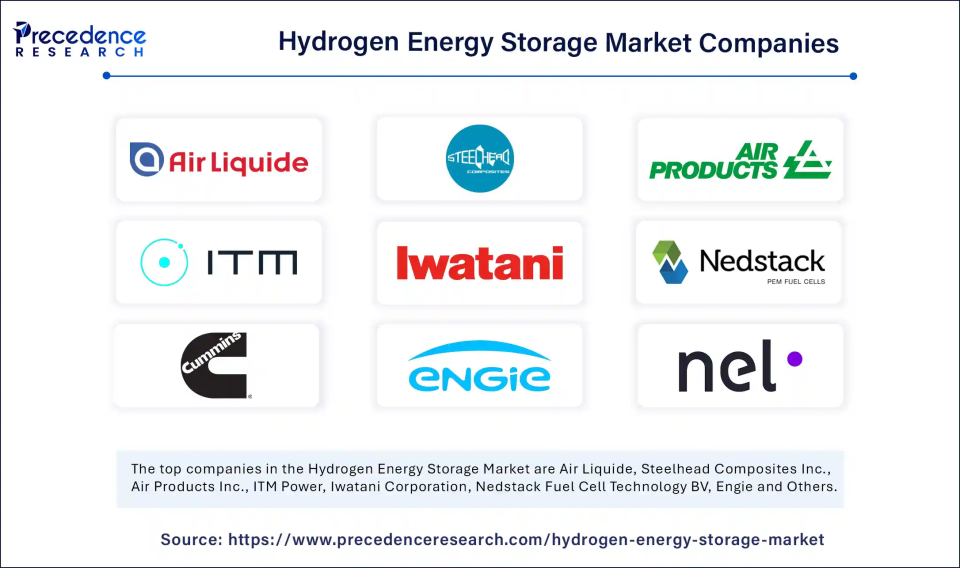
- Air Liquide
- Steelhead Composites Inc.
- Air Products Inc.
- ITM Power
- Iwatani Corporation
- Nedstack Fuel Cell Technology BV
- Cummins Inc.
- Engie
- Nel ASA
- Linde PLC
Recent Developments
- In April 2025, Energy Vault obtained USD 28 million in project finance to construct the Calistoga Resiliency Center, the world's first ultra-long duration hybrid green hydrogen energy storage microgrid. The facility is an example of the hydrogen energy storage and crime resiliency infrastructure integration.
- In April 2025, the Asian Development Bank authorized a USD 104 million loan to assist Georgia in the development of its inaugural energy storage facility and the possibility of hydrogen energy storage, which will be carried out through green hydrogen development. The project will combine a 200MW/200MWh Battery Energy Storage System and enhance legal frameworks to enhance hydrogen energy storage, which increases renewable energy capacity and energy security.
- In April 2025, Energy Vault entered a 10-year licensing/ manufacturing deal with India-based SPML Infra to license and assemble more than 30 GWh of its B-Vault mark battery energy storage systems (BESS), with an initial USD 100 million of 500 MWh capacity planned to be transferred within 12 months. The partnership involves the introduction of VaultOS software and the integration of hydrogen energy storage.
Segments Covered in the Report
By Technology
- Compression
- Liquefaction
- Material Based
By Physical State
- Solid
- Liquid
- Gas
By End User
- Residential
- Commercial
- Industrial
By Application
- Stationary Power
- Transportation
By Geography
- North America
- U.S.
- Canada
- Europe
- U.K.
- Germany
- France
- Asia-Pacific
- China
- India
- Japan
- South Korea
- Malaysia
- Philippines
- Latin America
- Brazil
- Rest of Latin America
- Middle East & Africa (MEA)
- GCC
- North Africa
- South Africa
- Rest of the Middle East & Africa
For inquiries regarding discounts, bulk purchases, or customization requests, please contact us at sales@precedenceresearch.com
Frequently Asked Questions
Ask For Sample
No cookie-cutter, only authentic analysis – take the 1st step to become a Precedence Research client
 sales@precedenceresearch.com
sales@precedenceresearch.com
 +1 804-441-9344
+1 804-441-9344